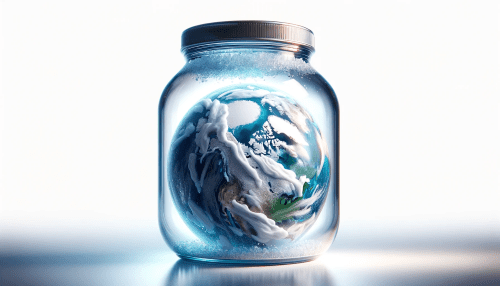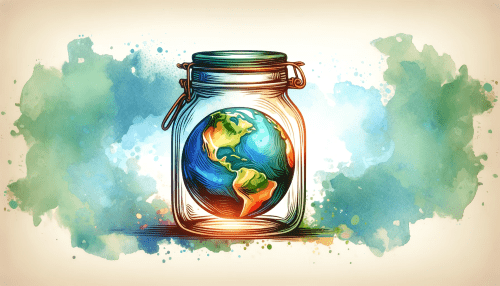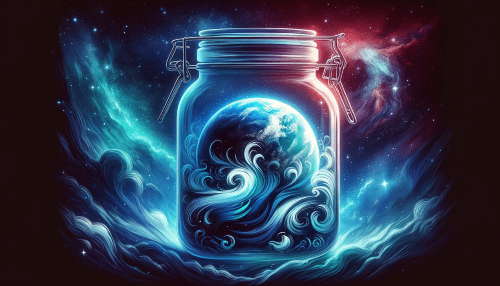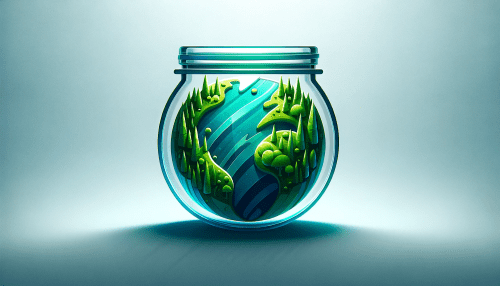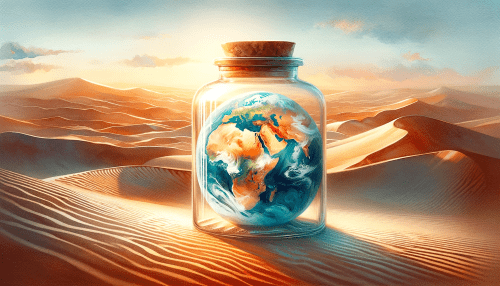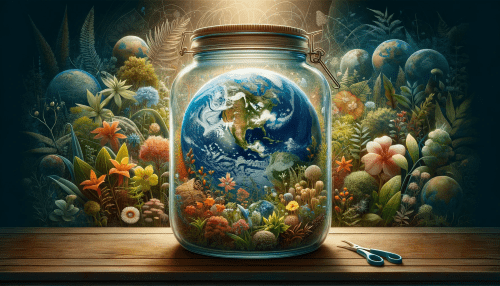Introduction:
In an arresting visual narrative, “Life in a Jar: An Artistic Examination of Social Isolation” casts the fragility of our blue planet into stark relief. Each brushstroke and hue converges to form a stark image: our Earth, with its dwindling polar ice caps, ensconced within the confines of a glass jar. These artworks transcend mere representation to become a profound statement on global warming, encapsulating the chilling solitude brought about by our environmental choices.
The thumbnail crafted for the blog article is a striking visual metaphor on the themes of climate change and global warming. The image features a strikingly realistic Earth, emphasizing the polar regions with their vivid white ice caps, encapsulated within a clear glass jar. The jar, sealed and immutable, underscores the theme of entrapment, symbolizing the Earth’s atmosphere that is increasingly trapping heat due to global warming. This encapsulation is not only a physical representation but also a metaphoric one, suggesting the isolation of our planet in the face of collective environmental challenges.
The realism of the Earth, with its true-to-life colors and textures, sits in stark contrast to the surreal concept of it being housed within a jar. The white background provides a sense of infinite space, further enhancing the isolated feel of the subject. The subtle interplay of light and shadow across the jar suggests the fragility of our world, a delicate orb poised within a vast, expansive universe. The artwork’s surrealism, blended with its realistic elements, serves to draw the viewer in, compelling them to ponder the implications of the image and the message it conveys.
Artwork 1: Frigid Solitude
Emphasizing the chilling isolation of the polar ice caps within the glass jar.
In this thought-provoking piece, we are invited to contemplate the Earth, not as the vast expanse we roam, but as a contained entity within the limits of a glass jar. The artwork is a watercolor rendering that captures the delicate balance of our planet’s polar ice caps, here dramatically shrunken and confined. The globe is tilted to expose the Arctic and Antarctic regions, now mere fragments of ice floating in a sea of blue, a poignant symbol of the melting ice in a warming world.
The jar, with its traditional wire clasp and rubber-sealed lid, suggests that this situation is man-made, sealed by our own hands. The transparency of the glass serves as a window into this microcosm, revealing the consequences of our environmental choices, while the stark white of the ice highlights the purity and fragility of what we stand to lose. The attention to detail in the painting, from the subtle reflections in the glass to the texture of the ice, emphasizes the realism and urgency of the subject matter.
This artwork compels the viewer to reflect on the isolated state of our environmental stewardship, provoking a conversation on the urgent need for collective action in the face of global warming. It’s a powerful call to acknowledge the barriers we’ve created and the responsibility we share to unlock a sustainable future for our planet.
Artwork 2: Melting Isolation
Highlighting the Earth’s vulnerability and the stark contrast between the ice caps and oceans.
The second artwork in the series continues the poignant narrative of our planet’s fragility. The Earth, cradled within the confines of a glass jar, is presented in an overhead perspective, emphasizing the polar regions. Here, the stark white of the ice contrasts sharply with the deep blues of the ocean, a visual testament to the isolation of the polar ice caps amidst the warming globe.
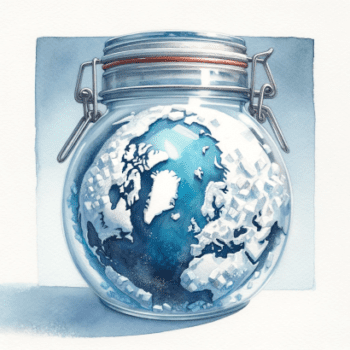 The watercolor technique used gives the painting a fluid, almost melting quality, mirroring the fate of the ice caps in our changing climate. The jar’s metal clasp, sealed shut, implies a finality, a barrier we have set which now needs urgent unfastening. The roundness of the jar distorts the continents, further underscoring the theme of distortion—how human actions have altered the natural state of the world.
The watercolor technique used gives the painting a fluid, almost melting quality, mirroring the fate of the ice caps in our changing climate. The jar’s metal clasp, sealed shut, implies a finality, a barrier we have set which now needs urgent unfastening. The roundness of the jar distorts the continents, further underscoring the theme of distortion—how human actions have altered the natural state of the world.
This piece invites the viewer to consider the Earth from a different angle, to see the world from above and recognize the interconnectedness of its ecosystems. It’s a perspective that urges us to step back and view our planet as a whole, understanding that the isolation of any part affects the integrity of the entire system.
This artwork is a call to re-evaluate our relationship with the Earth, to lift the lid on harmful practices, and to act with foresight and compassion. It serves not only as a reflection of current realities but also as a forewarning, an artistic plea for awareness and change.
Artwork 3: Crystal Metropolis
Reflecting the frozen stillness of a cityscape in juxtaposition with the Earth.
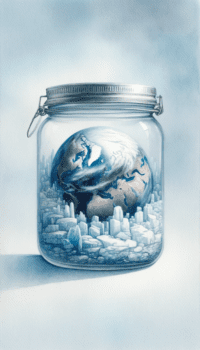
This third artwork takes the introspective theme to a new dimension by juxtaposing the image of Earth, suspended within the glass walls of the jar, against a backdrop of crystalline structures that evoke a cityscape turned to ice. The watercolor medium enriches the piece with a softness that belies the harsh reality it represents: a world where the natural and the man-made have collided, resulting in an eerie stillness.
The Earth itself, half-emerged from this frozen tableau, seems to be both part of and separate from the icy metropolis below. The continents are partially obscured, suggesting the encroaching impact of human expansion and the chilling effect it has on the planet. The polar ice, depicted with soft whites and blues, crowns the globe—a fragile halo at the brink of dissolution.
In this depiction, the jar is no longer just a container but a lens, focusing our attention on the delicate balance between urbanization and the natural world. The seal of the jar implies that this scene is locked in time, a moment of warning crystallized for us to witness.
With its cool palette and striking imagery, the artwork invites a reflection on the dualities it presents: warmth and cold, growth and decay, progress and preservation. It challenges the viewer to consider the paradoxes of our civilization and the precarious position in which we find ourselves.
The composition is a serene yet somber meditation on the consequences of our collective choices, urging us to look beyond the glass and consider the world we are shaping, both inside and outside the jar.
Artwork 4: Blue Drift
Capturing the Earth afloat in a jar, symbolic of the melting polar regions and rising seas.
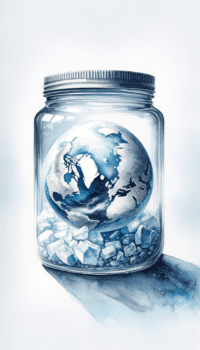
The fourth artwork offers a serene yet profound perspective on the theme of Earth’s fragility. In this portrayal, the planet floats within the confines of a mason jar, its iconic blue and white hues representative of the polar ice caps and vast oceans, yet here they are contained, almost suspended, in stasis within the glass walls.
The jar sits against a backdrop that dissolves into a wash of blues and whites, a watercolor echo of the melting ice that it symbolizes. It’s as if the Earth has been set adrift in an ocean of its own making, the icebergs that speckle its surface a reminder of what once was and what could be lost.
In this image, the Earth’s positioning within the jar creates an intimacy with the viewer. It’s a closeness that invites contemplation, a call to consider the delicate balance of our planet’s ecosystems. The purity of the white ice is stark against the deep sea blues, a visual representation of the contrast between the enduring strength of our planet and its susceptibility to change.
The jar, with its sealed lid, is a powerful metaphor for the barriers we have erected through our actions and inactions concerning climate change. It is both a vessel and a vault, a preserver of the now that also suggests the potential for change—the possibility of unlocking and releasing a future where balance is restored.
Through its subtle shading and the harmony of its color palette, this artwork evokes a sense of calm reflection on the impact of our environmental footprint. It’s a reminder that while the Earth may be our home, it is also a home we share—and one we must care for with foresight and unity.
Summary:
The series of artworks deftly illustrates a singular, chilling theme: the isolation of our planet as reflected in the melting ice at its poles. Within the transparent barriers of their jars, the Earths are depicted not as omnipotent globes but as vulnerable, isolated orbs. Their portrayal serves as a visual metaphor for the seclusion wrought by climate change—a self-imposed exile of our planet’s most vital and sensitive regions.
Conclusion:
This collection, “Life in a Jar,” is a compelling visual essay on the environmental perils facing our world. With each Earth encased and the polar ice prominently displayed, the artworks serve as a resonant reminder of the cold reality of global warming. This project invites viewers to shatter the glass of inaction, to release the Earth from its jar, and to foster a future where the polar ice is preserved, and our planet’s isolation is alleviated.
Support the Project:
The “Life in a Jar: An Artistic Examination of Social Isolation” project transcends the boundaries of art, inviting us into a deeper conversation about our planet and our place within it. We can all play a part in sustaining this profound narrative. Here are ways to support the project:
- Financial Contributions: Consider making a financial contribution to the project. Your donations will fuel the continuation of this creative exploration and help bring more themes to life. Every donation, big or small, makes a difference and allows the artists to delve deeper into this critical discourse.
- Artwork Acquisition: Each painting in the “Earth in a Jar” series is more than an image; it’s a story, a dialogue, a piece of a larger puzzle. By purchasing an individual artwork or a complete set, you not only become a custodian of this tale but also support the artists and their vision directly. These pieces are not just decor; they are conversations starters, heirlooms, and legacies.
- Join the Dialogue: After reading about the “Earth in a Jar” artworks, start a discussion with friends, family, or online communities. Share your thoughts, feelings, and insights. The conversation that begins in contemplation can lead to action and awareness, which are pivotal in addressing the themes of isolation and environmental responsibility.
- Spread the Word: If the “Life in a Jar” project resonates with you, become an advocate for its vision. Share articles, posts, and images on social media. Invite others to join the project community, to experience the art, and to become part of the growing conversation. The more we talk about these issues, the more we can do to address them.
- Host an Exhibition: If you have the means or connections, consider hosting an exhibition of the “Earth in a Jar” series in your local community center, gallery, or school. Physical exhibitions can bring people together and create a space for dialogue and connection. Please contact us to get started.
- Volunteer Your Skills: Are you a writer, a social media influencer, or an event organizer? Lend your skills to the project. By offering your expertise, you can help amplify the project’s message and reach a wider audience.
In whatever way you choose to support, you become part of a collective effort to not only appreciate the profound beauty of our world but to also preserve it. Together, through art and dialogue, we can inspire change and foster a more connected and conscious global community.

